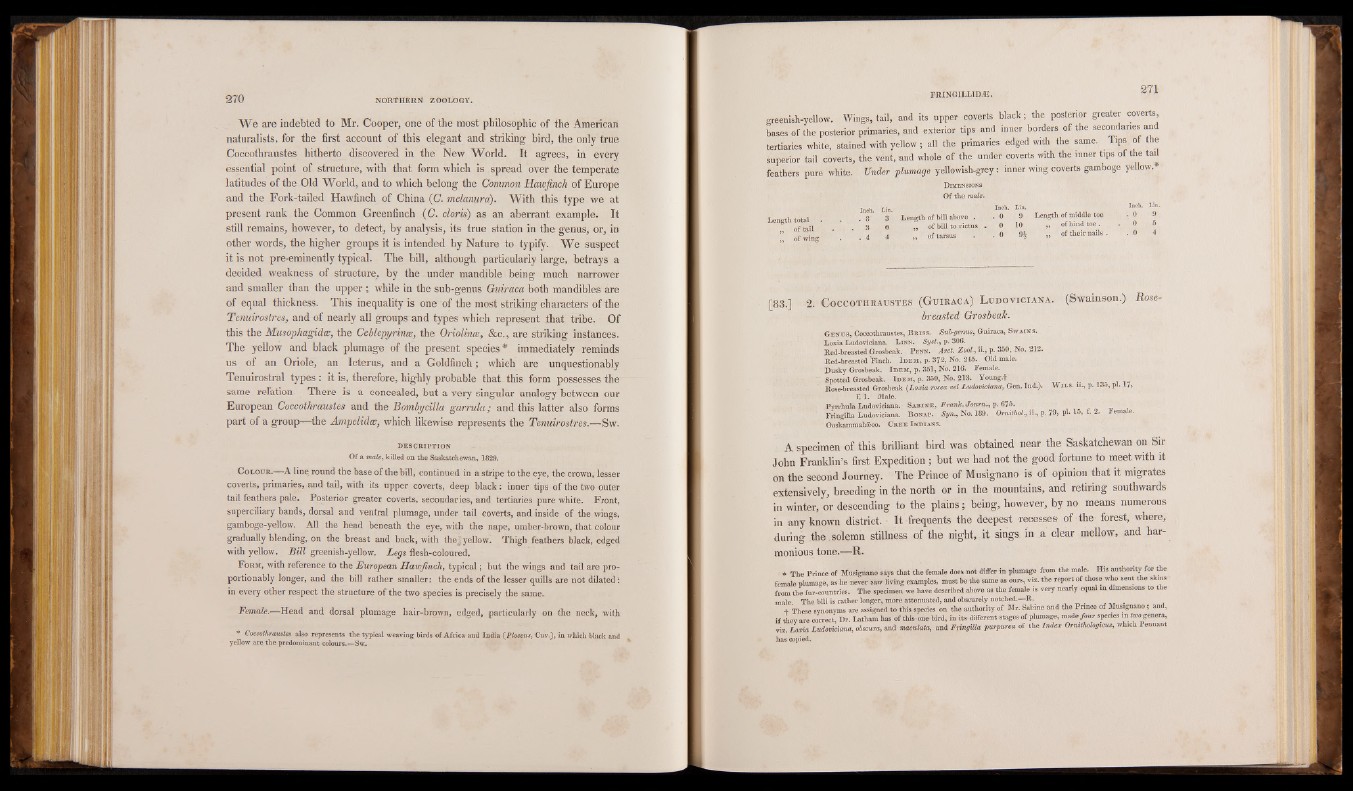
We are indebted to Mr. Cooper, one of the most philosophic of the American
naturalists, for the first account of this elegant and striking bird, the only true
Coccothraustes hitherto discovered in the New World. It agrees, in every
essential point of structure, with that form which is spread over the temperate
latitudes of the Old World, and to which belong the Common Hawfinch of Europe
and the Fork-tailed Hawfinch of China (C. melanura). With this type we at
present rank the Common Greenfinch (C. cloris) as an aberrant example. It
still remains, however, to detect, by analysis, its true station in the genus, or, in
other words, the higher groups it is intended by Nature to typify. We suspect
it is not pre-eminently typical. The bill, although particularly large, betrays a
decided weakness of structure, by the under mandible being much narrower
and smaller than the upper ; while in the sub-genus Quiraca both mandibles are
of equal thickness. This inequality is one of the most striking characters of the
Tenuirostres, and of nearly all groups and types which represent that tribe. Of
this the Musophagidce, the Ceblepyrinw, the Oriolince, &c„ are striking instances.
The yellow and black plumage of the present species* immediately reminds
us of an Oriole, an Icterus, and a Goldfinch; which are unquestionably
Tenuirostral types : it is, therefore, highly probable that this form possesses the
same relation. There is a concealed, but a very singular analogy between our
European Coccothraustes and the Bomh/cilla garrula; and this latter also forms
part of a group—the Ampelidw, which likewise represents the Tenuirostres.—Sw.
DESCRIPTION
Of a male, killed on the Saskatchewan, 1829.
C olour. A line round the base of the bill, continued in a stripe to the eye, the crown, lesser
coverts, primaries, and tail, with its upper coverts, deep black : inner tips of the two outer
tail feathers pale. Posterior greater coverts, secondaries, and tertiaries pure white. Front,
superciliary bands, dorsal and ventral plumage, under tail coverts, and inside of the wings,
gamboge-yellow. All the head beneath the eye, with the nape, umber-brown, that colour
gradually blending, on the breast and back, with the] yellow. Thigh feathers black, edged
with yellow. Bill greenish-yellow. Legs flesh-coloured.
Form, with reference to the European Hawfinch, typical; but the wings and tail are proportion
ably longer, and the bill rather smaller: the ends of the lesser quills are not dilated \
in every other respect the structure of the two species is precisely the same.
Female.—Head and dorsal plumage hair-brown, edged, particularly on the neck, with
* Coccothraustes also represents the typical weaving birds of Africa and India ( Ploceus, Guv.), in which black and
yellow are the predominant colours.—Sw.
greenish-yellow. Wings, tail, and its upper coverts black; the posterior greater coverts,
bases of the posterior primaries, and exterior tips and inner borders of the secondaries and
tertiaries white, stained with yellow; all the primaries edged with the same. Tips of the
superior tail coverts, the vént, and whole of the under coverts with the inner tips of the tail
feathers pure white. Under plumage yellowish-grey: inner wing coverts gamboge yellow*
Dimensions
Of the male.
Inch. Lin.
Length total . . . 8 8
J't 1 1, of tail. . . 3 0
„ of wing . . 4 4
Inch. Lin.
Length of hill above . . 0 9
„ of bill to rictus . 0 10
„ of tarsus . . 0 9f
Inch. Lin.
Length of middle toe - 0 9
„ of hind toe. . 0 5
of their nails . . 0 4
[83.] 2. C o c c o t h r a u s t e s (G u ir a c a ) L u d o v ic ia n a . (Swainson.) Rosebreasted
Grosbeak.
Ge n u s , Coccothraustes, B r is s . Sub-genus, Guiraca, Swains.
Loxia Ludoviciana. L inn. Syst., p. 306.
Red-breasted Grosbeak. P enn. Arct. ZooL,ii., p. 350, No. 212.
Red-breasted Finch. Idem, p. 372, No. 245. Old male.
Dusky Grosbeak. I d em , p. 351, No. 216. Female.
Spotted Grosbeak. I dem, p. 350, No. 213. Young.f
Rose-breasted Grosbeak (.Loxia rosea vel Ludoviciana, Gen. Ind.). Wins, u;, p. 135, pi. 17,
T.l. Male.
Pyrrhula Ludoviciana. Sa b in e , Frank. Joum., p. 675. Fringilla Ludoviciana. B onap. Syn., No. 189. Omithol., ii., p. 79, pi- 15, f. 2. Female.
Ooskammahffioo. Cr.e e I ndians.
A specimen of this brilliant bird was obtained near the Saskatchewan on Sir
John Franklin’s first Expedition; but we had not the good fortune to meet with it
On the second Journey. The Prince of Musignano is of opinion that it migrates
extensively, breeding in the north or in the mountains, and retiring southwards
in winter, or descending to the plains; being, however, by no means numerous
in any known district. It frequents the deepest recesses of the forest, where,
during the .solemn stillness of the night, it sings in a clear mellow, and har-
monious tone.—R.
* The Prince of Musignano says that the female does not differ in plumage from the male. His authority for the
female plumage, as he never saw living examples, must be the same as ours, viz. the report of those who sent the skins
from the fur-countries. The specimen we have described above as the female is very nearly equal m dimensions to the
male The bill is rather longer, more attenuated, and obscurely notched.—R.
+ These synonyms are assigned to this species on the authority of Mr. Sabine and the Prince of Musignano; and,
if they are correct, Dr. Latham has of this one bird, in its different stages of plumage, made four species in two genera,
viz. Loxia Ludoviciana, obscura, and maculate, and Fringilla purpurea of the Index Omithologicus, which Pennant
has copied.